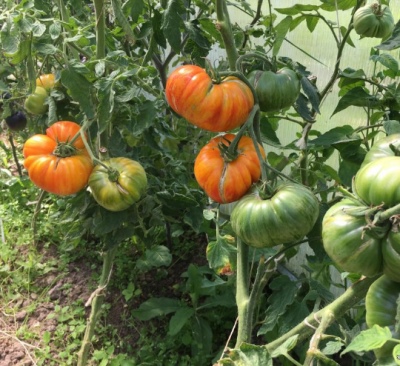
- Authors: USA
- Name synonyms: Burracker's Favorite, Burraker's Favorite
- Category: grade
- Growth type: indeterminate
- Appointment: fresh consumption, for juice, for ketchup and tomato paste
- Ripening period: mid-season
- Growing conditions: for open ground, for greenhouses
- Bush size: tall
- Bush height, cm: 180
- Bush characteristic: powerful
Foreign varieties of tomatoes are popular among Russian gardeners. Tomato Burrakerskie pets - one of these varieties.
Description of the variety
The Burrakerskie pets variety is a crop with unlimited growth power. In open ground, the height of the bush reaches 1.8 m, in closed ground - 2 m. The stem is powerful, thick. There are many leaves on the bush. They are medium in size, somewhat reminiscent of potato tops. The color is deep green, matte. The plate has a characteristic middle section, the back surface is rough.
Since the bush grows quickly, it is necessary to think over a trellis system or drive in pegs nearby. Not only the stem is tied up, but also the branches. The first inflorescence is formed at the level of 7 leaves from the ground. Up to 8 fruits ripen on the brush. For better development, it is recommended to leave only 2 stems at the bush.
The advantages of the variety include:
- taste qualities;
- excellent drought tolerance;
- marketable condition;
- excellent keeping quality;
- ability to transport.
Negative points:
- the need to remove excess shoots;
- tying up the stem and hands;
- impossibility of holistic preservation of the fruit.
The main qualities of the fruit
Burraker pets bear very large fruits. They are flat-round in shape, flattening is expressed in the region of the top and bottom. The weight of one tomato can reach 600 g. The largest fruits are formed on the lower branches. The higher the branch, the smaller the tomato will be.
Ripe fruits are yellow-orange or red-orange in color. The skin is dense, glossy, there is a slight ribbing, and the stalk has a characteristic dent. The pulp is firm, juicy, not watery. There are cameras in the amount of 5-6 pieces. There are few seeds, they are rather small.
Most often, the Burraker pets are used to prepare juices, sauces and ketchups. Canned less often, since the fruit will have to be cut.
Taste characteristics
The variety has a unique taste. There is a high sugar content without a sour taste, there are fruity notes.
Ripening and fruiting
Burraker pets are mid-season crops. The harvest falls in August.
Yield
The yield of the variety is average. 4-4.5 kg are removed from one bush. From 1 m2 - 10-11 kg indoors, outdoors - 9 kg.
The timing of planting seedlings and planting in the ground
Seed sowing starts in early March. Much depends on where the crop will subsequently be grown. It is necessary to prepare the boxes. The seeds should be pre-soaked in melt water, and before sowing, soak in a cotton wool soaked in a solution of potassium permanganate. The holes for the seeds are made shallow, only 2 cm. The boxes are covered with foil and placed on the windowsill. The seedlings must receive plenty of light for the seeds to hatch and grow. If there is not enough light, then it is necessary to use special UV lamps.
A dive occurs when 2-3 strong leaves have formed in the bushes. In early May, the seedlings are moved to the yard for hardening. Landing in open ground is carried out in the second decade of May.

Growing tomato seedlings is an extremely important process, because it largely depends on whether the gardener can harvest at all.All aspects must be taken into account, from seedbed preparation to planting in the ground.
Landing scheme
The area for tomatoes should be dug up in advance. It is best to do this in the fall, while fertilizing the soil with useful minerals. Before planting seedlings, the land is abundantly irrigated.
A hole is dug 40 cm deep. The distance between the bushes should be 50-60 cm, as they are spreading. It is best to plant the bushes in a checkerboard pattern, so that later it will be easier to process the seedlings, remove excess foliage and harvest. 50 cm is also left between the rows.
Before planting the seedlings, pegs or trellises are prepared for tying.

Growing and care
To get a good harvest, the following rules must be followed.
- Normalized watering. Tomatoes are spilled with water about 2 times a week. Much depends on the weather conditions. The water should be warm and settled.
- It is necessary to mulch the soil. The Burraker pets variety does not like too dry air. This can make the pollen sterile. Mulch will also help keep the soil hydrated, which means that the risk of fungal diseases will be lower.
- Feeding is worth 4-5 times per season. It is best to first feed with potassium and nitrogen, during flowering and fruit formation - with fluorine. All top dressing is applied at the root.
- It is worthwhile to carry out pinching in a timely manner and remove excess sheets, especially at the bottom (they interfere with air circulation).
- Weed the soil as needed. During weeding, you can loosen the soil a little to saturate it with oxygen.




A plant needs different micronutrients at each stage of growth. All fertilizers can be divided into two groups: mineral and organic. Folk remedies are often used: iodine, yeast, bird droppings, eggshells.
It is important to observe the rate and period of feeding. This also applies to folk remedies and organic fertilizers.



























































































